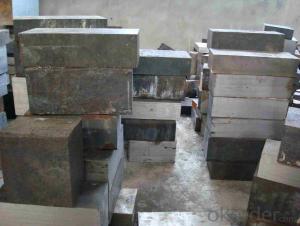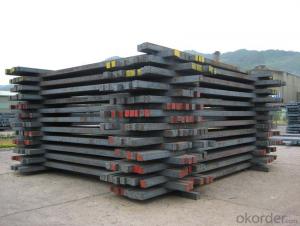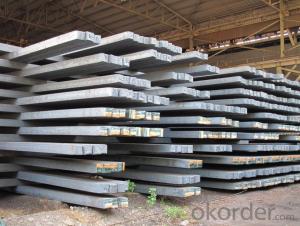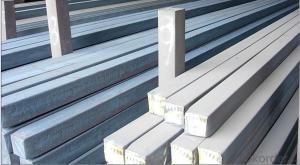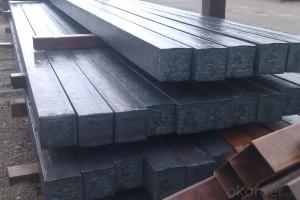Hot Rolled Square Steel Billet 3SP Standard 110mm
- Loading Port:
- Shanghai
- Payment Terms:
- TT OR LC
- Min Order Qty:
- 2000 m.t.
- Supply Capability:
- 10000 m.t./month
OKorder Service Pledge
OKorder Financial Service
You Might Also Like
Structure of Hot Rolled Square Steel Billet 3SP Standard 110mm

Description of Hot Rolled Square Steel Billet 3SP Standard 110mm
PPGI is made by cold rolled steel sheet and galvanized steel sheets as baseplate, through the surface pretreatment (degreasing, cleaning, chemical conversion processing), coated by the method of continuous coatings (roller coating method),
and after roasting and cooling. Zinc coating: Z60, Z80, Z100, Z120, Z180, Z275, G30, G60, G90
Alu-zinc coating: AZ60, AZ80, AZ100, AZ120, AZ180, G30, G60, G90
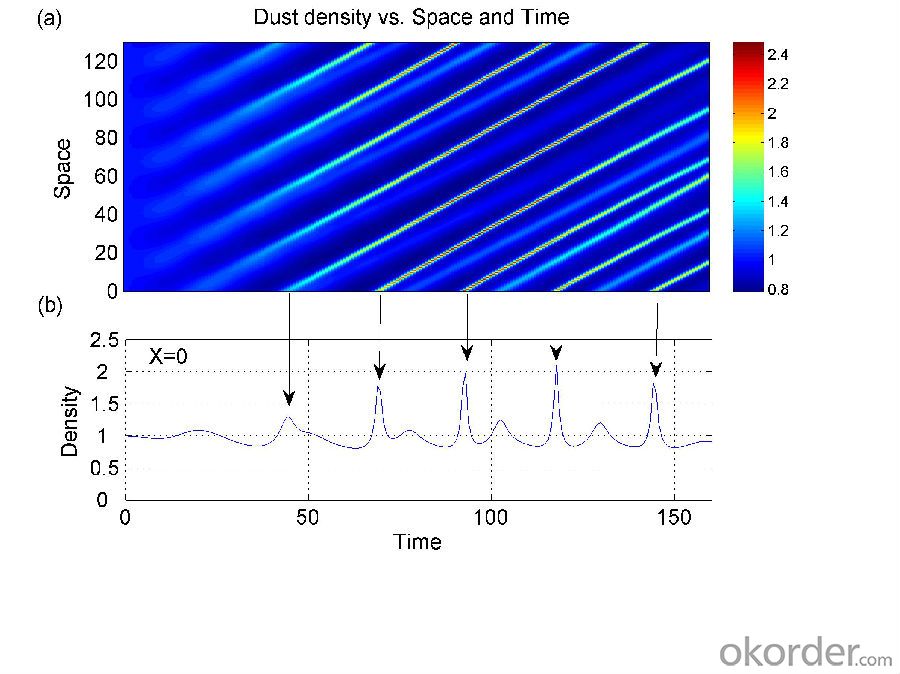
Main Feature of Hot Rolled Square Steel Billet 3SP Standard 110mm
1) Excellent corrosion resistance: The zinc layer provides a good protection of Pre-painted Galvanizeed Steel Sheet.
2) High heat resistance: The reflective surface of the material aids in efficiently reflecting the sunlight away and in turn reducing the amount of heat transmitted. The thermal reflectivity converts into energy savings.
3) Aesthetics: Pre-Painted Galvanized steel sheet is available in plethora of patterns and multiple sizes as per the requirements that given by our customers.
4) Versatility: can be used in the various areas.Standard seaworthy export packing: 3 layers of packing, inside is kraft paper, water plastic film is in the middle and outside GI steel sheet to be covered by steel strips with lock, with inner coil sleeve.
Applications of Hot Rolled Square Steel Billet 3SP Standard 110mm
1) Automotive bodies: filters, fuel tanks, etc.
2) Construction materials: roofings, welding pipes,
3) Electric and electronic appliances: computer cans, etc.
4) Steel cans: containers, etc.
5) Steel furniture: washing machines, refrigerators, microwaves, etc.
6) Drums
7) Office equipment: printer, recorders, etc.
8) Motors and transformers

Specifications of Hot Rolled Square Steel Billet 3SP Standard 110mm
| Classified symbol | Yield Point Minimum N/mm2 | Tensile Strength Minimum | Elongation Minimum % | Application | ||||
| N/mm2 | Nominal Thickness mm (t) | |||||||
| JIS | Yogic | 0.25-0.4 | 0.4-0.6 | 0.6-1.0 | 1.0-1.6 | |||
| G3312 | specification | |||||||
| CGCC | CGCC | -205 | -270 | -20 | -21 | -24 | -24 | Commercial |
| CGCD | CGCD | --- | 270 | --- | 27 | 31 | 32 | Drawing |
| --- | CG340 | 245 | 340 | 20 | 20 | 20 | 20 | Structural |
| CGC400 | CG400 | 295 | 400 | 16 | 17 | 18 | 18 | Structural |
| CGC440 | CG440 | 335 | 440 | 14 | 15 | 16 | 18 | Structural |
| CGC490 | CG490 | 365 | 490 | 12 | 13 | 14 | 16 | Structural |
| CGC570 | CG570 | 560 | 570 | --- | --- | --- | --- | Structural |
| ASTM Designation | Yield Point Minimum | Tensile Strength Minimum | Elongation Minimum % | Application | Q/BQB 445-2004(China standard) | ASM A653/A653M | JISG 3312 | |
| ksi(MPa) | ksi(MPa) | TDC51D+Z | (CS TYPE A+Z) | CGCC | ||||
| A653(M)-99 CS TYPE A,B,C | --- | --- | --- | Commercial | TDC52D+Z | CGCD | ||
| A653(M)-99 FS | --- | --- | --- | Lock Forming | TS250GD+Z | (G250+Z) | - | |
| A653(M)-99 DS | --- | --- | --- | Drawing | TS300GS+Z | (G300+Z) | CGC 400 | |
| A653(M)-99 SS Grade33(230) | 33(230) | 45(310) | 20 | Structural | TS350GD+Z | (G350+Z) | CGC490 | |
| A653(M)-99 SS Grade37(255) | 37(255) | 52(360) | 18 | Structural | TS550GD+Z | (G550+Z) | CGC570 | |
| A653(M)-99 SS Grade40(275) | 40(275) | 55(380) | 16 | Structural | ||||
| A653(M)-99 SS Grade50(345) | 50(345) | 65(450) | 12 | Structural | ||||
| A653(M)-99 SS Grade80(550) | 80(550) | 82(570) | --- | Structural | ||||
FAQ of Hot Rolled Square Steel Billet 3SP Standard 110mm
We have organized several common questions for our clients,may help you sincerely:
1. How Can I Visit There?
Our company is located in Tianjin City, China, near Beijing. You can fly to Tianjin Airport Directly. All our clients, from home or aboard, are warmly welcome to visit us!
2. How Can I Get Some Sample?
We are honored to offer you sample.
3. Why choose CNBM?
1, ISO, BV, CE, SGS approved.
2, Competitive price and quality.
3, Efficient service team online for 24 hours.
4, Smooth production ability(50000tons/month) .
5, quick delivery and standard exporting package.
6, Flexible payment with T/T, L/C, Paypal, Kunlun bank, etc .
- Q:Can steel billets be used in the production of appliances?
- Yes, steel billets can be used in the production of appliances. Steel billets are semi-finished products that are typically used for further processing into various shapes and sizes. In the case of appliances, steel billets can be used as the raw material for manufacturing components such as frames, panels, and other structural parts. Steel is a versatile and durable material that offers strength, stability, and resistance to corrosion, making it suitable for use in appliances that require robust construction. Additionally, steel can be easily molded and shaped to meet the specific design requirements of different appliances, making it a preferred choice in the manufacturing process.
- Q:What are the different types of steel billets used in the manufacturing industry?
- There are several different types of steel billets used in the manufacturing industry, each with its own unique properties and qualities. Some of the most common types include: 1. Carbon Steel Billets: These are the most widely used type of steel billets and are made primarily from iron and carbon. They are known for their high strength and durability and are used in a variety of applications, including construction, automotive, and machinery manufacturing. 2. Alloy Steel Billets: Alloy steel billets are made by adding various alloying elements to carbon steel, such as manganese, nickel, chromium, and molybdenum. This results in improved properties such as increased strength, hardness, and resistance to corrosion. They are often used in the production of high-strength components and machinery parts. 3. Stainless Steel Billets: Stainless steel billets are made from iron, chromium, and other alloying elements, such as nickel and molybdenum. They are highly resistant to corrosion and staining and are commonly used in the manufacturing of kitchen appliances, automotive parts, and medical equipment. 4. Tool Steel Billets: Tool steel billets are specifically designed for use in the production of tools, dies, and molds. They have high hardness, wear resistance, and toughness, making them ideal for applications that require cutting, shaping, or molding materials. 5. Micro-Alloyed Steel Billets: These billets contain small amounts of alloying elements, such as vanadium, niobium, or titanium. They are used to improve the strength and toughness of the steel, making them suitable for structural applications in industries such as construction and transportation. It's important to note that these are just a few examples of the different types of steel billets used in the manufacturing industry. There are many other specialized types available, each tailored to meet specific requirements for different applications and industries.
- Q:What are the different methods of steel billet surface grinding?
- There are several methods of steel billet surface grinding, including abrasive grinding, belt grinding, and centerless grinding.
- Q:What industries use steel billets?
- Several industries use steel billets, including automotive, construction, manufacturing, and infrastructure. Steel billets are commonly used as raw material in the production of various metal products such as pipes, rods, bars, wires, and sheets. They are also utilized in the construction of bridges, buildings, and other structural components. The automotive industry uses steel billets for manufacturing parts like engine blocks, chassis, and suspension components. Additionally, steel billets find applications in the energy sector, machinery production, and shipbuilding.
- Q:How are steel billets used in the manufacturing of automotive chassis?
- Due to their strength and durability, steel billets are essential in the production of automotive chassis. Obtained through casting molten steel into a rectangular shape, they serve as the raw material for various automotive components, including the chassis. The automotive chassis provides structural support and stability to the vehicle, bearing the load and impacts during driving. The main frame of the chassis, made from steel billets, forms the backbone of the vehicle. To shape the steel billets, they are heated and passed through rolling mills. This process increases their strength and rigidity, making them suitable for the demanding conditions of the chassis. The billets are then welded together using techniques like arc welding or laser welding to create the chassis structure. This ensures a solid and reliable connection that can withstand the stresses and forces experienced during operation. Using steel billets in the manufacturing of automotive chassis offers several advantages. Steel's high tensile strength allows it to withstand heavy loads and impacts without deforming or failing. It also has excellent fatigue resistance, ensuring the structural integrity of the chassis under repeated stress cycles. Additionally, steel is readily available, cost-effective, and easily recyclable, making it a preferred choice for automotive manufacturers. Its excellent corrosion resistance is crucial for vehicles exposed to various weather conditions and road environments. In conclusion, steel billets are crucial for manufacturing automotive chassis as they provide the necessary strength and durability. Shaped and welded together, they form the main frame of the chassis, ensuring the safety and performance of the vehicle under demanding driving conditions.
- Q:What are the properties of alloy steel billets?
- Alloy steel billets possess a combination of properties that make them highly desirable for various applications. These properties include high strength, excellent hardness and wear resistance, good toughness, and improved corrosion resistance compared to carbon steel. Additionally, alloy steel billets have the ability to withstand high temperatures and exhibit excellent machinability, making them ideal for use in industries such as automotive, aerospace, construction, and manufacturing.
- Q:What is the impact of impurities on the quality of steel billets?
- The presence of impurities in steel billets can significantly impact their quality. Impurities can weaken the structural integrity of the steel, reduce its toughness, and make it more prone to cracking or failure. They can also affect the steel's ability to resist corrosion, resulting in reduced durability and lifespan. Additionally, impurities can interfere with the steel's ability to be machined or welded, limiting its usability in various industries. Therefore, controlling and minimizing impurities in steel billets is crucial to ensure high-quality and reliable end products.
- Q:Can steel billets be forged into complex shapes?
- Complex shapes can be achieved by forging steel billets. The process involves heating the billet to a specific temperature, usually above its recrystallization temperature, and then applying pressure to shape it. Various forging techniques like open die, closed die, or impression die forging can be used. Steel is highly malleable and can be easily shaped and deformed under heat and pressure. This property allows steel billets to be forged into intricate shapes like gears, turbine blades, automotive parts, and other components used in different industries. Forging not only shapes the billet but also enhances its mechanical properties, making it stronger and more durable. The resulting forged steel has a refined grain structure, improving its toughness, resistance to fatigue, and resistance to cracking. However, forging complex shapes from steel billets requires skilled craftsmanship and specialized equipment. The process may involve multiple steps like pre-forming, rough forging, and finish forging to achieve the desired shape and dimensions. Computer-aided design (CAD) and computer-aided manufacturing (CAM) technologies are often used to optimize the forging process and ensure precision and accuracy. To sum up, steel billets can be forged into intricate shapes. Through forging, the malleability of steel is harnessed to create components with improved mechanical properties.
- Q:How are steel billets used in the manufacturing of telecommunications equipment?
- Steel billets are used in the manufacturing of telecommunications equipment as they serve as raw material for various components such as brackets, frames, and enclosures. These billets are shaped and machined into precise forms to provide structural support and protection for sensitive electronic components within telecommunications devices. Additionally, steel billets may also be used in the production of antenna towers and infrastructure, ensuring stability and durability in the telecommunications industry.
- Q:Refinery carbon 3 is propane, then carbon four carbon five is what name ah?.What are they used for?
- Carbon four is butane, C4H10 carbon five is pentane C5H12
1. Manufacturer Overview |
|
|---|---|
| Location | |
| Year Established | |
| Annual Output Value | |
| Main Markets | |
| Company Certifications | |
2. Manufacturer Certificates |
|
|---|---|
| a) Certification Name | |
| Range | |
| Reference | |
| Validity Period | |
3. Manufacturer Capability |
|
|---|---|
| a)Trade Capacity | |
| Nearest Port | |
| Export Percentage | |
| No.of Employees in Trade Department | |
| Language Spoken: | |
| b)Factory Information | |
| Factory Size: | |
| No. of Production Lines | |
| Contract Manufacturing | |
| Product Price Range | |
Send your message to us
Hot Rolled Square Steel Billet 3SP Standard 110mm
- Loading Port:
- Shanghai
- Payment Terms:
- TT OR LC
- Min Order Qty:
- 2000 m.t.
- Supply Capability:
- 10000 m.t./month
OKorder Service Pledge
OKorder Financial Service
Similar products
New products
Hot products
Related keywords
